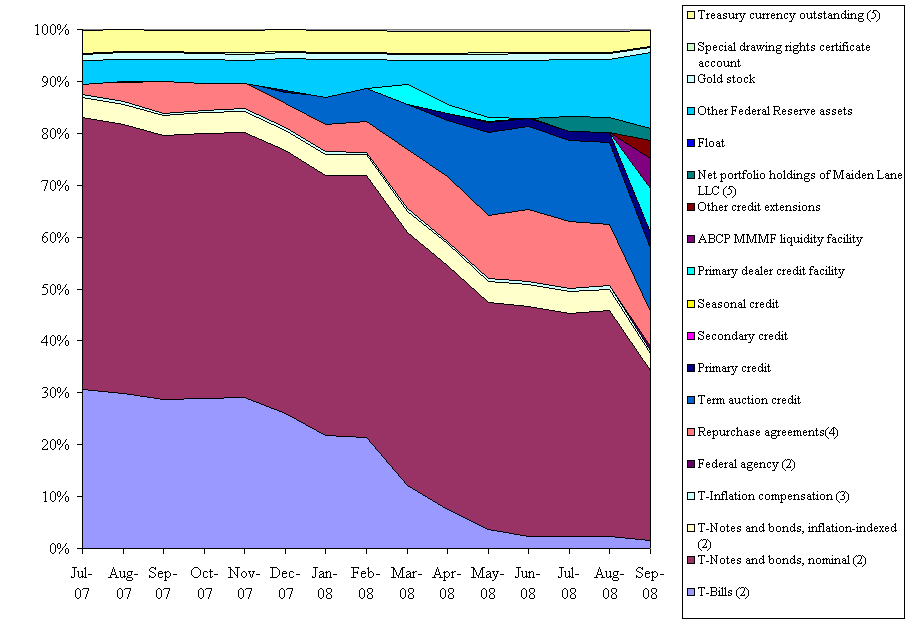The House vote rejecting the Bailout bill leaves us where we were before: the Treasury, FDIC, Fed, and all the quasi-financial arms of the government do one-off bailouts as needed.? That may be better than the proposed? bailout for a number of reasons.
- For raw reasons of liberty, it is good to keep the government reactive rather than proactive.
- The bailout as proposed did not meet our most pressing needs.? Our biggest problems are in the short-term lending markets, and the bailout did not address that directly.
- Doing triage on the banks, and recapitalizing the survivors (at a price) may have been the optimal strategy.? Why save non-regulated entities?
- The prior actions of the Fed and Treasury aimed at the short-term lending markets.
My last piece on this topic was pessimistic.? I am still pessimistic, even as the Fed expands the dollar swap facilities, and the TAF.? The commerical paper market is shrinking.? People are fleeing Municipal Money Market Funds.? The repo market is freezing.? And, longer maturity investment grade credit is hurting as well.
There will be limits at some point, though.? Look at a scaled version of the asset side of the Fed’s balance sheet:
Now, the lowest quality assets of the Fed are in the middle of the graph. Also note that until the last month, total assets at the Fed were fairly constant. Now add in the expansion of the TAF.? Does the Fed decrease its holdings of Treasuries still further, or does the Treasury keep creating more Treasuries and give them to the Fed?
This game could continue on for a while.? The Treasury and Fed create credit using the balance sheet of the US Government and the Fed, and use it to bail out damaged lending markets.? And, as I measure it, that has already supplied $500 billion or so to the lending markets, with another $300 billion or so on the way.
My question: if the prior bailouts through the Fed have not worked, why should the proposed $700 billion bailout work, particularly when it is targeted at longer term assets of banks?
A couple of notes before I close:
- This piece that Barry cites is a great read.? I have long felt that our nation as a whole blames its politicians too much, and does not blame itself enough.
- Yesterday was my biggest percentage and dollar loss ever.
- Adding insult to injury, I accidentally destroyed my main work computer by spilling juice on it.? My productivity has fallen.


There is nothing wrong with being pessimistic in the current situation. I’m sorry of course for your dollar loss and losing your computer at the same time. That is terribly unpleasant especially for those of us whose work relies on that equipment.
And I don’t expect that Battleship Hartford is helping your results again today. Same old story with insurance companies as investments…opaque until it’s too late.
On 486.578 billions of T-Bill/Notes, 190.532 billions are lent to banks, so these T-bill/Notes are not in full control of the fed.
So, I suggest you to add a new usage called “securities lent to dealers” as in 1A.memorandum Items of fed’s balance sheet statement : http://www.federalreserve.gov/releases/h41/Current/
So, T-Bill/Notes are not 38% but only 25% of the fed’s balance sheet, the other 13% are lent to dealers.
Note :
– “Term Facility” part of “securities lent to dealers” is the “Term Securities Lending Facility”. see ”
For Release at
4:30 P.M. Eastern time
April 3, 2008
The Board’s H.4.1 statistical release, “Factors Affecting Reserve Balances of
Depository Institutions and Condition Statement of Federal Reserve Banks,” has
been modified to include a separate line for securities lending conducted under
the Term Securities Lending Facility (TSLF), which was announced on March 11,
2008. ” http://www.federalreserve.gov/releases/h41/20080403/
So, you could have 2 items, one for TSLF, and one for “overnight securities lent to dealers”
call “Battleship Hartford” the Bismarck. I have already apologized for this one.
Thanks, Vincent. I have tried to incorporate this into later posts.